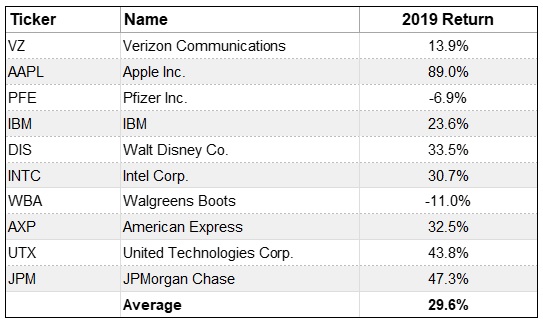Meet The 2020 Dobermans Of The Dow
Submitted by Silverlight Asset Management, LLC on December 31st, 2019
Two years ago, I introduced Forbes readers to the “Dobermans of the Dow.” The Dobermans are my version of the “Dogs of the Dow” strategy, which Michael O’Higgins popularized via his 1991 book, Beating the Dow.
Using O’Higgins’ approach, investors will typically buy the ten stocks from the Dow Jones Industrial Average (DJIA) with the highest dividend yields at the start of each year.
My approach, on the other hand, focuses on two different variables.
Step 1: Rank Dow constituents by Return on Equity (ROE), keeping the top 20.
Step 2: Rank remaining names by Free Cash Flow Yield, keeping the top 10.
Those final ten names are your Dobermans.
The Dobermans of the Dow outperformed again this year, consistent with the historical trend. The 2019 Dobermans generated a total return of 29.6% compared to 25.3% for the Dow.

Source: Bloomberg
Here is a look at relative performance, since I first introduced the Dobermans screen at the beginning of 2018.

Investors have been following the Dogs of the Dow strategy for decades, which is a remarkable achievement. Investing fads come and go like stars in Hollywood—most are just a flash in the pan. Few have staying power.
Will the Dobermans have staying power?
The only certainty in investing is uncertainty. And I’m sure there will be future years when the strategy falls short. It’s inevitable.
That said, I’m optimistic the Dobermans of the Dow is a strategy individual investors can pursue with confidence for years to come.
Several factors lead me to that conclusion.
1) Historical performance. If you’re not backtesting your investing process, you’re guessing, which is equivalent to gambling. It’s really that simple.
We all know the past doesn’t perfectly repeat itself. But wouldn’t you rather have history on your side instead of working against you? Especially if you’re putting your life savings on the line?
Encouragingly, past performance is on the Dobermans’ side. The Dobermans have outperformed the DJIA in 18 of the last 22 years, averaging a 14.4% annual return. The cumulative return of this simple, 10-stock portfolio is +1,227% versus +502% for the Dow.

Source: Bloomberg
2) Markets are not perfectly efficient. Even huge, widely followed companies populating the Dow can become mispriced.
For instance, the following table shows the annual trading range of last year’s Dobermans. The average percentage change between the 52-week high and low was 46%. Did the underlying value of these massive enterprises really change that much?
Source: Bloomberg
If the market were perfectly efficient, the answer would be yes. But it’s a tough sell when you consider the underlying dynamics. Market prices are more volatile than underlying business fundamentals.
Apple is the most glaring example. At the stock’s nadir in January 2019, the market cap was around $675 billion. In less than twelve months, Apple’s market cap has swelled to $1.3 trillion. The $625 billion swing exceeds the value of Walt Disney, Pfizer and IBM combined.
Did the folks in Cupertino really create more value this year than those three corporate behemoths did over their entire histories? Probably not.
Interestingly, 2020 will be the first time since 2015 Apple fails to qualify as a Doberman.
3) Fundamental advantage. Unlike a lot of equity strategies, the Dobermans have outperformed across numerous style cycles. That is likely because the screen mixes growth and value factors in the selection criteria.
In my original article about the strategy, I said, “The Dogs of the Dow strategy only asks one question: how cheap? And it makes a narrow comparison in delineating that by only considering dividend yields.”
Takeaway: the Dogs of the Dow is basically a value strategy.
I also wrote, “The Dobermans of the Dow is a better companion tool for investors, because it’s more dynamic. It starts by sorting Dow constituents by a quality metric (ROE). Then, among those higher quality names, it compares prices in a more universally applicable way (FCF yield)."
A fundamental truism is that quality and valuation both impact an investor’s “margin of safety.” Keeping that in mind, the probability of an individual investor achieving a very poor result following the Dobermans strategy is low.
- All the Dobermans are large, world-class businesses.
- The average ROE for the 2020 Dobermans is 30%; effectively double the S&P 500.
- The average FCF yield for the 2020 Dobermans is 6.5%, whereas you get a 3.8% yield buying an S&P 500 index fund (source: Bloomberg).
So, if you view the Dobermans as a “conglomerate,” you own a diverse mix of mega firms, with above-average profitability, whose shares are relatively cheap compared to the cash they generate.
Hardly a recipe for disaster.
You can reduce the number of unforced errors in your portfolio by favoring high-quality businesses that earn high returns on capital. For more on this subject, I encourage you to read Warren Buffett’s 1987 Letter to Shareholders.
If you want to learn more about why free cash flow yield is a useful metric, I recommend checking out this post by yours truly.
Now, let’s meet the 2020 Dobermans of the Dow. Good luck in the new year!

Source: Bloomberg
Originally published by Forbes. Reprinted with permission.
Disclosure: I own IBM, WBA, AXP, CSCO, VZ, INTC, MMM, PFE, JNJ and CAT in accounts I professionally manage. This material is not intended to be relied upon as a forecast, research or investment advice. The opinions expressed are as of the date indicated and may change as subsequent conditions vary. The information and opinions contained in this post are derived from proprietary and nonproprietary sources deemed by Silverlight Asset Management LLC to be reliable, are not necessarily all-inclusive and are not guaranteed as to accuracy. As such, no warranty of accuracy or reliability is given and no responsibility arising in any other way for errors and omissions (including responsibility to any person by reason of negligence) is accepted by Silverlight Asset Management LLC, its officers, employees or agents. This post may contain “forward-looking” information that is not purely historical in nature. Such information may include, among other things, projections and forecasts. There is no guarantee that any of these views will come to pass. Reliance upon information in this post is at the sole discretion of the reader.
Testimonials Content Block
More Than an Investment Manager—A Trusted Guide to Financial Growth
"I’ve had the great pleasure of having Michael as my investment manager for the past several years. In fact, he is way more than that. He is a trusted guide who coaches his clients to look first at life’s bigger picture and then align their financial decisions to support where they want to go. Michael and his firm take a unique and personal coaching approach that has really resonated for me and helped me to reflect upon my core values and aspirations throughout my investment journey.
Michael’s focus on guiding the "why" behind my financial decisions has been invaluable to me in helping to create a meaningful strategy that has supported both my short-term goals and my long-term dreams. He listens deeply, responds thoughtfully, and engages in a way that has made my investment decisions intentional and personally empowering. With Michael, it’s not just about numbers—it’s about crafting a story of financial growth that has truly supports the life I want to live."
-Karen W.
Beyond financial guidance!
"As a long-term client of Silverlight, I’ve experienced not only market-beating returns but also invaluable coaching and support. Their guidance goes beyond finances—helping me grow, make smarter decisions, and build a life I truly love. Silverlight isn’t just about wealth management; they’re invested in helping me secure my success & future legacy!"
-Chris B.
All You Need Know to Win
“You likely can’t run a four-minute mile but Michael’s new book parses all you need know to win the workaday retirement race. Readable, authoritative, and thorough, you’ll want to spend a lot more than four minutes with it.”
-Ken Fisher
Founder, Executive Chairman and Co-CIO, Fisher Investments
New York Times Bestselling Author and Global Columnist.
Packed with Investment Wisdom
“The sooner you embark on The Four-Minute Retirement Plan, the sooner you’ll start heading in the right direction. This fun, practical, and thoughtful book is packed with investment wisdom; investors of all ages should read it now.”
-Joel Greenblatt
Managing Principal, Gotham Asset Management;
New York Times bestselling author, The Little Book That Beats the Market
Great Full Cycle Investing
“In order to preserve and protect your pile of hard-earned capital, you need to be coached by pros like Michael. He has both the experience and performance in The Game to prove it. This is a great Full Cycle Investing #process book!”
-Keith McCullough
Chief Executive Officer, Hedgeye Risk Management
Author, Diary of a Hedge Fund Manager
Clear Guidance...Essential Reading
“The Four-Minute Retirement Plan masterfully distills the wisdom and experience Michael acquired through years of highly successful wealth management into a concise and actionable plan that can be implemented by everyone. With its clear guidance, hands-on approach, and empowering message, this book is essential reading for anyone who wants to take control of their finances and secure a prosperous future.”
-Vincent Deluard
Director of Global Macro Strategy, StoneX

